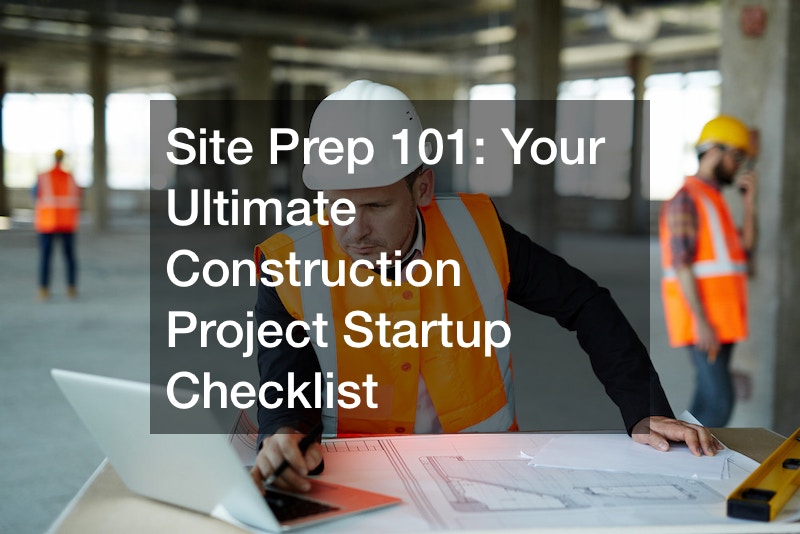
Do you know why about 98% of large construction projects suffer cost overruns, with many delivered late? It’s because of a lack of a solid startup plan. Anyone who has managed a construction project, whether building a house or a business office, will tell you how challenging and overwhelming it is. But you don’t have to go through the same struggle others do. Here is your construction project startup checklist to get you started.

Finding the Perfect Plot
The first step of your construction project should be finding a suitable spot to set up the structure. This will vary depending on various factors. Therefore, you must first define your goals and understand your project well before choosing a suitable spot for construction. Here are a few pointers to help you pick the perfect land for your construction project.
Consider the Location
We cannot overstate the importance of location. Where you build your house or any structure will influence many factors, such as value. Therefore, a construction project startup checklist should always start with finding an ideal location. Now, when choosing a site for your construction project, there are several things you must consider.
First, define your needs and goals. Are you building a house for yourself and your family or a structure for business purposes? If it’s a house, you’re free to follow your preferences. For instance, you can choose a remote, quiet place free from city noises. However, if it’s a commercial construction, say a shop or business office, you need a place close to the city or your customers.
For commercial structures, you can consider a location close to workplaces, schools, amenities, and public transport. These features play a pivotal role in determining your property’s value. If it’s a residential property, such as a house, you want to assess your neighborhood and its growth potential.
Zoning and Regulations
Another crucial aspect of our construction project startup checklist is the rules and regulations that govern the use of a specific land (often known as zoning laws). Each jurisdiction or location has its own zoning laws that must be followed. And in most cases, the rules are meant to manage and control land development, protect property values, and build communities more responsibly.
Therefore before choosing a plot to start your construction project, you must understand the local zoning regulations and building codes. These regulations dictate the type of structure you can build, its size, and the setback from property lines. A clear understanding of and adhering to these rules will help prevent future legal issues.
Land Topography and Soil Conditions
The height and design of a building are sometimes defined by the topography and soil conditions in the area. For instance, the wrong type of soil can cause your foundation to become weak or cause the building to sink or collapse. This is why you must always conduct soil tests to determine the right type of land to build on. If the area is sloppy, an architect design firm can help you come up with the right design for your house or building. Foundation designs and construction methods are informed mainly by the soil’s composition and stability.
Infrastructure and Utilities
Whether you want to build a house or a structure for your business, you need access to essential infrastructure and utilities. But not all areas have access to adequate water, electricity, and other essential utilities. Therefore, when choosing a site for your construction, ascertain the availability and cost of internet connectivity, electricity, water, and other crucial utilities and infrastructure.

Complete all Processes Legally
If you already have land for your construction project, then perhaps you’ll only have a problem choosing a suitable site. However, if you’re buying land, you’ll need to complete numerous and sometimes lengthy processes before owning the land. It’s essential to follow all legal procedures of land purchasing to prevent disputes and other legal issues.
You might want to hire a licensed and experienced lawyer to help you navigate all the legalities of buying land. The goal is to follow legal procedures and ensure no disputes arise after the sale. You also need to ensure you have all the land ownership documents after the purchase before commencing your construction project.
Laying the Groundwork
So now you have your ideal plot, and it’s time to begin the actual construction. But before anything else, you must set the stage for the entire construction project. The foundation is the backbone of any structure, providing stability and support. Lay a weak foundation, and you could risk people’s lives, including yours. This makes site preparation a crucial part of the construction project startup checklist. Here’s how to prepare your land for a significant construction project.
Site Assessment and Survey
The importance of site surveys and assessments before a major construction project cannot be overstated. It’s an essential step that every residential or commercial builder must undertake before erecting any structure. Site survey offers valuable data and insights that inform every aspect of the construction process, from planning and design to execution and maintenance.
First, the survey helps your architects and engineers understand the site’s natural features, topography, and existing structures. We already talked about how land topography and soil composition affect construction projects. Therefore, the information obtained will be handy in designing a structure that fits the landscape, minimizing the need for extensive alterations.
A thorough site survey and assessment help engineers decide on the best foundation type and construction methods to ensure the stability and longevity of the structure to be built. This stage also reveals any environmentally sensitive areas such as water bodies and wetlands. Identifying these areas early helps you design your structure around them or identify the necessary processes, such as dredging, to minimize environmental impact.
Clearing the Site
If the site is ideal for your construction project, you can now move to the next item on the construction project startup checklist, which is site clearing. However, not all sites will require clearing. For instance, some lands are free from trees, rocks, and other structures. Therefore, not much work is needed to prepare the site. But for those with vegetation, debris, or any obstacles, site clearing is mandatory.
Site clearing involves the following;
- Vegetation removal:
If the land has shrubs, weeds, trees, or any other vegetation that may hinder the construction, they must be removed. This involves tree removal, uprooting plants, and clearing any vegetation that could interfere with the construction process.
- Debris and obstacle removal:
This involves removing debris like stones, rocks, and discarded materials. The process creates a smooth and hazard-free environment for your construction project.
- Demolition of existing structures:
If there is any existing structure on the site, this is the time to have it removed. You may demolish the structure partially or wholly.
Site clearing aims to create a safe and accessible work environment for your construction crew and equipment. Remember, obstacles like trees or existing foundations could obstruct movement or increase the risk of accidents and injuries. So, if the site is cleared, your crew will have an easy time moving equipment, aluminum building products, and machinery.
Moreover, you’ll have a clear view of the land’s topography and conditions. Therefore, your architects and engineers can easily and accurately plan the project’s layout, foundation, and other design elements. While you can clear the site yourself, we recommend hiring a land clearing contractor to help you complete the process safely. These professionals have the proper knowledge, experience, and equipment to clear the site without causing any risks.

Site Excavation
Sometimes you may need to add excavation as an item on your construction project startup checklist. This step involves preparing the site for building. Excavating the land sets the foundation for the entire project. Therefore, it’s a crucial step in construction. Your excavating method will depend on your site. You can choose from tunneling, dredging, or trenching.
The excavation process is complex and often requires careful planning and execution. Depending on the laws in your region, you may need to obtain permits and approvals before executing this step. This helps prevent legal disputes and consequences in the future. If you’re unsure of what’s needed, be sure to consult qualified professionals.
Additionally, excavation may involve shoring and sloping to prevent cave-ins and collapses. Shoring involves installing supportive structures, while sloping involves gradually angling the sides of the excavation to avoid soil collapse. It’s worth noting that excavation is not only for creating space for the foundation. It’s often required for the installation of utility lines such as sewer, water, and electrical conduits.
Deeper excavations may also be needed to accommodate basements or underground structures. So, if you’re considering building an underground garage, you’ll need excavation on your construction project startup checklist. Generally, excavation is important to create the space needed to install the building’s foundation.
Footings and Sub-base
Footings are the base upon which the foundation walls rest. They are typically made of concrete but can also be made using brick, stone, or even wood. Your choice will depend on the type of soil on the site and the type and size of the building.
Footings distribute the building’s weight evenly across the entire structure to stop it from sinking into the ground. They also prevent water and moisture from seeping into your foundation. Remember, water can cause cracks and other damage to your foundation. In simple terms, footing refers to the bottom of a building’s foundation.
On the other hand, the sub-base helps prevent the pumping of fine-grained, subgrade soils. Excess water under the pavement, frequent heavy truck loads, and the presence of pumpable soils often result in pumping, leading to soil material loss beneath joints and slab edges. A stable sub-base layer ensures the foundation’s longevity.

Formwork and Reinforcement
Formwork is used to mold the concrete into the desired shape. Reinforcement, such as steel bars, add strength to the foundation. The primary function of the formwork is to safely support the reinforced concrete until it reaches adequate strength.
Formwork can be a temporary structure or a permanent mold. Properly placed reinforcement prevents cracking and enhances the foundation’s ability to withstand external forces. Therefore, it’s an essential step in any construction process. Once the formwork and reinforcement are in place, you can now pour concrete into the forms. The foundation design and local weather conditions will dictate the concrete mix and pouring technique.
Curing, Backfilling, and Compaction
Once you’ve poured the concrete, give it time to cure and achieve its optimal strength. The curing process will vary based on the concrete mix and the weather conditions. Have a qualified professional inspect the foundation during the curing process to ensure it meets the required standards.
Once the foundation is cured and inspected, you’ll need to fill the excavated area around the foundation in a process known as backfilling. Also, note that proper compaction is ideal to prevent settling and potential damage to the foundation.
Tips to Help You Start Your Construction Project Successfully
This construction project startup checklist might not be enough to help you complete your construction project successfully. You also need some tips and guidance to ensure the safety and success of the project. So if you’re planning a major construction project, here are some tips for you;
- Don’t rush the process; We know you want to complete your construction project as soon as possible. However, we recommend taking your time to complete every stage highlighted in the construction project startup checklist above.
- Hire qualified persons:
Even if you’re qualified and experienced, you’ll need help to build a house or complete a large construction project. Sometimes you may need a wrecker service to help you move essential equipment and machinery.
- Get the right building supplies; We insist on getting quality materials for your construction projects.
Are you planning a major construction project, perhaps building a house? You might be excited and overwhelmed. However, our construction project startup checklist is what you need to kick-start your project.




